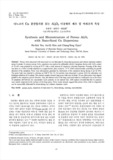

PARTNER
검증된 파트너 제휴사 자료
나노크기 Cu 분산입자를 갖는 Al2O3 다공체의 제조 및 미세조직 특성 (Synthesis and Microstructure of Porous Al2O3 with Nano-Sized Cu Dispersions)
5 페이지
최초등록일 2025.03.13
최종저작일
2013.01

-
서지정보
· 발행기관 : 한국재료학회
· 수록지 정보 : 한국재료학회지 / 23권 / 1호 / 67 ~ 71페이지
· 저자명 : 유호석, 현창용, 김안기
초록
Porous Al2O3 dispersed with nano-sized Cu was fabricated by freeze-drying process and solution chemistry method using Cu-nitrate. To prepare porous Al2O3, camphene was used as the sublimable vehicle. Camphene slurries with Al2O3 content of 10 vol% were prepared by milling at 50 oC with a small amount of oligomeric polyester dispersant. Freezing of the slurry was done in a Teflon cylinder attached to a copper bottom plate cooled to −25 oC while unidirectionally controlling the growth direction of the camphene. Pores were subsequently generated by sublimation of the camphene during drying in air for 48 h.
The green body was sintered in a furnace at 1400 oC for 1 h. Cu particles were dispersed in porous Al2O3 by calcination and hydrogen reduction of Cu-nitrate. The sintered samples showed large pores with sizes of about 150 μm; these pores were aligned parallel to the camphene growth direction. Also, the internal walls of the large pores had relatively small pores due to the traces of camphene left between the concentrated Al2O3 particles on the internal wall. EDS analysis revealed that the Cu particles were mainly dispersed on the surfaces of the large pores. These results strongly suggest that porous Al2O3 with Cu dispersion can be successfully fabricated by freeze-drying and solution chemistry routes.영어초록
Porous Al2O3 dispersed with nano-sized Cu was fabricated by freeze-drying process and solution chemistry method using Cu-nitrate. To prepare porous Al2O3, camphene was used as the sublimable vehicle. Camphene slurries with Al2O3 content of 10 vol% were prepared by milling at 50 oC with a small amount of oligomeric polyester dispersant. Freezing of the slurry was done in a Teflon cylinder attached to a copper bottom plate cooled to −25 oC while unidirectionally controlling the growth direction of the camphene. Pores were subsequently generated by sublimation of the camphene during drying in air for 48 h.
The green body was sintered in a furnace at 1400 oC for 1 h. Cu particles were dispersed in porous Al2O3 by calcination and hydrogen reduction of Cu-nitrate. The sintered samples showed large pores with sizes of about 150 μm; these pores were aligned parallel to the camphene growth direction. Also, the internal walls of the large pores had relatively small pores due to the traces of camphene left between the concentrated Al2O3 particles on the internal wall. EDS analysis revealed that the Cu particles were mainly dispersed on the surfaces of the large pores. These results strongly suggest that porous Al2O3 with Cu dispersion can be successfully fabricated by freeze-drying and solution chemistry routes.참고자료
· 없음태그
-
자주묻는질문의 답변을 확인해 주세요

꼭 알아주세요
-
자료의 정보 및 내용의 진실성에 대하여 해피캠퍼스는 보증하지 않으며, 해당 정보 및 게시물 저작권과 기타 법적 책임은 자료 등록자에게 있습니다.
자료 및 게시물 내용의 불법적 이용, 무단 전재∙배포는 금지되어 있습니다.
저작권침해, 명예훼손 등 분쟁 요소 발견 시 고객센터의 저작권침해 신고센터를 이용해 주시기 바랍니다. -
해피캠퍼스는 구매자와 판매자 모두가 만족하는 서비스가 되도록 노력하고 있으며, 아래의 4가지 자료환불 조건을 꼭 확인해주시기 바랍니다.
파일오류 중복자료 저작권 없음 설명과 실제 내용 불일치 파일의 다운로드가 제대로 되지 않거나 파일형식에 맞는 프로그램으로 정상 작동하지 않는 경우 다른 자료와 70% 이상 내용이 일치하는 경우 (중복임을 확인할 수 있는 근거 필요함) 인터넷의 다른 사이트, 연구기관, 학교, 서적 등의 자료를 도용한 경우 자료의 설명과 실제 자료의 내용이 일치하지 않는 경우
찾으시던 자료가 아닌가요?
지금 보는 자료와 연관되어 있어요!
문서 초안을 생성해주는 EasyAI


